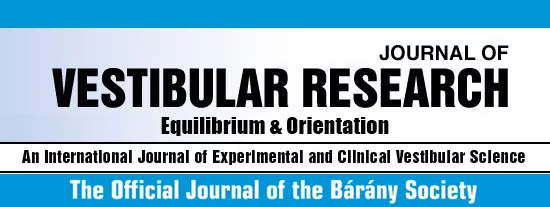Motion sickness diagnostic criteria: Consensus Document of the Classification Committee of the Bárány Society
Motion Sickness Disorder (MSD) and Visually Induced Motion Sickness (VIMS) are normal responses to physical or visual motion, but can be considered a disorder in individuals that are especially susceptible or significantly impacted. The Bárány Society has developed criteria to help diagnose individuals with these disorders.
Diagnostic Criteria
Generalized motion sickness is differentiated from what would be considered a “disorder” as follows:
Generalized motion sickness and visually induced motion sickness (VIMS)
- Physical motion of the person or visual motion elicits sign(s) and/or symptom(s) in at least one of the following categories, experienced at greater-than-minimal severity:
- Nausea and/or gastrointestinal disturbance
- Thermoregulatory disruption
- Alterations in arousal
- Dizziness and/or vertigo
- Headache and/or ocular strain
- Sign(s) and/or symptom(s):
- appear during motion and build as exposure is prolonged
- eventually stop after cessation of motion
- are not better accounted for by another disease or disorder
Motion sickness disorder (MSD) and visually induced motion sickness disorder (VIMSD)
- At least five episodes of motion sickness/VIMS triggered by the same or similar motion stimuli
- Sign(s) and/or symptom(s):
- are reliably triggered by the same or similar motion stimuli
- severity does (do) not significantly decrease after repeated exposure to the same or similar motion stimuli
- lead to one or more of the following behavioral or emotional responses:
- Activity modification to reduce sickness sign(s)/symptom(s)
- Avoidance of the motion stimulus that triggers sickness
- Aversive anticipatory emotions prior to exposure to the motion stimulus
- are not better accounted for by another disease or disorder
Susceptibility and Severity
Susceptibility to motion sickness in normal individuals is not a strong predictor of susceptibility to VIMS. Nausea and vomiting are less common in VIMS than in motion sickness, whereas ocular issues (e.g., eyestrain, blurred vision) and headache are more common. Older adults are more susceptible to VIMS but not to motion sickness than younger adults. Motion sickness frequency and severity can be reduced by avoiding or limiting exposure to sickness-inducing stimuli, by modifying behavior during exposure (e.g., limiting head movements), by taking medications prior to exposure, by utilizing earth-referenced cues (e.g., viewing the outside world), or through gradual exposure to offending motion via habituation.
Common Treatments
Common treatments include prescription of habituation exercises, prophylactic medications (anti-muscarines, anti-histamines, anticholinergics), alternative treatments (music, smells), and behavioral strategies (breathing exercises, meditation). The use of ginger or acupressure for motion sickness is common, but the empirical evidence for these interventions is mixed. The methods with the greatest benefits appear to be through adaptation, medications, and modifying behavior during exposure. Habituation is often stimulus-specific and may not generalize across all motion situations.
The Clinical Features of Motion Sickness
Prevalance
Motion sickness in childhood has been estimated at 35–43% prior to puberty and 25% in young adults; it is a frequent problem in 14% of adults younger than 30 years old and 7% of adults 61 years old or older. VIMS ranges widely depending on stimulus type and visual content, with rates varying from 1% to 60% to 80–95%.
Demographics
Age
Infants are resistant to motion sickness until about age 2, after which susceptibility rises, peaking between the ages of 7–12 years and declining through adulthood. VIMS increases with age, with older adults reporting more VIMS than younger adults.
Sex
The literature has not yet demonstrated a consensus on sex differences in motion sickness susceptibility. Sex differences in VIMS have been observed in some studies, but again the overall case is weak for biological male/female differences.
Race and ethnicity and Genetics
A partial heritable component to motion sickness was observed, with heightened susceptibility in people of Asian descent compared to European or African descent, though further studies are needed.
Associated syndromes
Migraine
Motion sickness is self-reported in at least 50% of migraine sufferers with childhood motion sickness correlating with the development of migraines later in life. Research suggests that neural pathways for nausea and emesis are particularly sensitive in individuals with migraine. Migraine headache sufferers experience both motion sickness and VIMS to a higher degree than those without migraine, but the correlation is weak.
Structural vestibular disorders
Patients with chronic stable vestibular loss (unilateral and bilateral) report less motion sickness than healthy controls. In comparison, patients with benign paroxysmal positional vertigo fail to show a significant difference in motion sickness susceptibility. Vestibular neuritis can result in either an increase or a decrease in motion sickness susceptibility after its onset, with increased susceptibility in uncompensated cases. Two studies have shown that those with Ménière’s disease are more susceptible to motion sickness but are not as susceptible as those with migraine. No difference was noted between the degree of caloric asymmetry in vestibular patients and motion sickness ratings. In contrast, patients with vestibular disorders without vestibular loss report higher degrees of motion sickness than controls.
The Impact of MSD and VIMSD
Motion sickness is a normal physiological reaction and should only be considered a disorder when it affects an individual’s ability to perform activities of daily life. This includes a reduction in school or work productivity, activity avoidance, the use of pharmacological remedies, or mental health changes. Disability can be determined and quantified by pairing formal disability scales (e.g. Sheehan Disability Scale) with an existing motion sickness or VIMS scale. As a basic assessment, The Social Life and Work Impact of Dizziness short form can be easily adapted for motion sickness.
For most individuals, education, exposure minimization, avoidance of aggravating behaviors, short-term use of anti-motion sickness medications, or simple habituation exercises may be used to reduce disability. In cases where VIMS or motion sickness does not rise to the level of a disability, it should still be recognized as a condition that may benefit from intervention.
Written by Joon Nah BScBiol, BScPT
Source
Cha, Yoon-Hee, et al. “Motion Sickness Diagnostic Criteria: Consensus Document of the Classification Committee of the Bárány Society.” Journal of Vestibular Research, IOS Press, 4 Oct. 2021, https://content.iospress.com/articles/journal-of-vestibular-research/ves200005.

